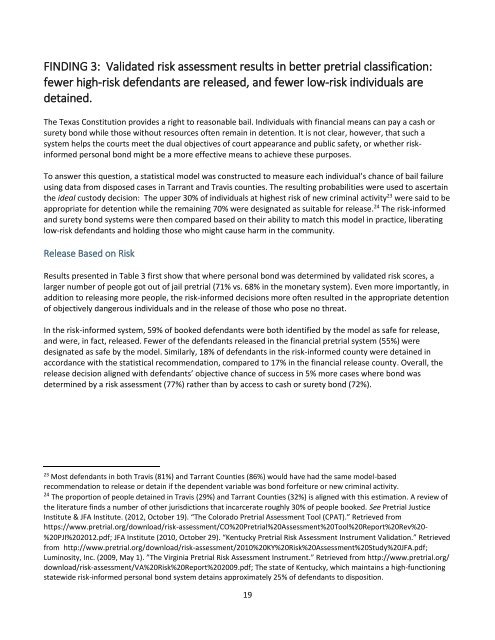LIBERTY AND JUSTICE PRETRIAL PRACTICES IN TEXAS
170308_bond-study-report
170308_bond-study-report
Create successful ePaper yourself
Turn your PDF publications into a flip-book with our unique Google optimized e-Paper software.
F<strong>IN</strong>D<strong>IN</strong>G 3: Validated risk assessment results in better pretrial classification:<br />
fewer high-risk defendants are released, and fewer low-risk individuals are<br />
detained.<br />
The Texas Constitution provides a right to reasonable bail. Individuals with financial means can pay a cash or<br />
surety bond while those without resources often remain in detention. It is not clear, however, that such a<br />
system helps the courts meet the dual objectives of court appearance and public safety, or whether riskinformed<br />
personal bond might be a more effective means to achieve these purposes.<br />
To answer this question, a statistical model was constructed to measure each individual’s chance of bail failure<br />
using data from disposed cases in Tarrant and Travis counties. The resulting probabilities were used to ascertain<br />
the ideal custody decision: The upper 30% of individuals at highest risk of new criminal activity 23 were said to be<br />
appropriate for detention while the remaining 70% were designated as suitable for release. 24 The risk-informed<br />
and surety bond systems were then compared based on their ability to match this model in practice, liberating<br />
low-risk defendants and holding those who might cause harm in the community.<br />
Release Based on Risk<br />
Results presented in Table 3 first show that where personal bond was determined by validated risk scores, a<br />
larger number of people got out of jail pretrial (71% vs. 68% in the monetary system). Even more importantly, in<br />
addition to releasing more people, the risk-informed decisions more often resulted in the appropriate detention<br />
of objectively dangerous individuals and in the release of those who pose no threat.<br />
In the risk-informed system, 59% of booked defendants were both identified by the model as safe for release,<br />
and were, in fact, released. Fewer of the defendants released in the financial pretrial system (55%) were<br />
designated as safe by the model. Similarly, 18% of defendants in the risk-informed county were detained in<br />
accordance with the statistical recommendation, compared to 17% in the financial release county. Overall, the<br />
release decision aligned with defendants’ objective chance of success in 5% more cases where bond was<br />
determined by a risk assessment (77%) rather than by access to cash or surety bond (72%).<br />
23<br />
Most defendants in both Travis (81%) and Tarrant Counties (86%) would have had the same model-based<br />
recommendation to release or detain if the dependent variable was bond forfeiture or new criminal activity.<br />
24<br />
The proportion of people detained in Travis (29%) and Tarrant Counties (32%) is aligned with this estimation. A review of<br />
the literature finds a number of other jurisdictions that incarcerate roughly 30% of people booked. See Pretrial Justice<br />
Institute & JFA Institute. (2012, October 19). “The Colorado Pretrial Assessment Tool (CPAT).” Retrieved from<br />
https://www.pretrial.org/download/risk-assessment/CO%20Pretrial%20Assessment%20Tool%20Report%20Rev%20-<br />
%20PJI%202012.pdf; JFA Institute (2010, October 29). “Kentucky Pretrial Risk Assessment Instrument Validation.” Retrieved<br />
from http://www.pretrial.org/download/risk-assessment/2010%20KY%20Risk%20Assessment%20Study%20JFA.pdf;<br />
Luminosity, Inc. (2009, May 1). ”The Virginia Pretrial Risk Assessment Instrument.” Retrieved from http://www.pretrial.org/<br />
download/risk-assessment/VA%20Risk%20Report%202009.pdf; The state of Kentucky, which maintains a high-functioning<br />
statewide risk-informed personal bond system detains approximately 25% of defendants to disposition.<br />
19


